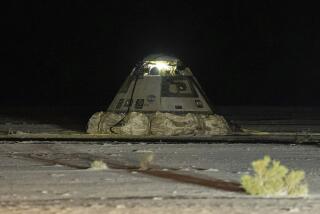Nighttime Landing Ends Shuttle Mission
KENNEDY SPACE CENTER, Fla. — Space shuttle Atlantis and its crew swooped through the darkness Monday and ended a triumphant repair mission to the international space station.
Within moments of touchdown, the seven astronauts were basking in praise.
“Just a super mission,” Mission Control said.
Infrared cameras tracked Atlantis on final approach; the shuttle resembled a ghost ship in the grainy black-and-white pictures.
The view switched to inside the cockpit just before the 2:20 a.m. landing, and the floodlighted runway and center line were easily distinguishable from the pilots’ seats.
It was only the 14th time in 98 flights that a space shuttle landed in darkness. The crosswind ended up being well within safety limits, despite NASA’s earlier concerns.
The astronauts’ handiwork, the rejuvenated space station, had passed over the Kennedy Space Center just 10 minutes earlier and was crossing the North Atlantic when Atlantis touched down.
All four newly installed batteries were working fine and providing full electrical power to the space station.
“I know it’s bad hours for the arrival, but we are certainly glad to be back home,” Cmdr. James Halsell Jr. said.
Halsell and his crew immediately inspected scratches and dents in the thermal tiles covering the bottom of each shuttle wing. The scrapes happened during liftoff May 19 and were noticed when NASA reviewed video of the launch.
Engineers suspect the wings were hit by chunks of ice that fell off the external fuel tank. The ice sometimes forms because of the super-cold liquid fuel inside, officials said.
Halsell said the damage turned out to be “nothing extraordinary,” even though NASA had him take special precautions in preparing for landing.
Besides replacing bad batteries, the six Americans and one Russian furnished the 1 1/2-year-old space station with a new antenna, construction crane, fire extinguishers, smoke detectors and fans. They also boosted the complex into an orbit more than 230 miles high, 30 miles higher than before.
Halsell said it was sometimes stressful trying to squeeze everything into the six days that the spacecraft were docked.
But Halsell noted with visible pride that the outcome was “a resounding success and something of a resurgence for the international space station program.”
Now that it’s back in top form, the space station will fly solo until July. That’s when Russia’s long-delayed service module is supposed to arrive. Once that happens, space station compartments will start soaring, and astronauts and cosmonauts will begin moving in.
After more than two years of delay, the service module finally appears to be ready, said NASA Administrator Daniel S. Goldin. The space agency wants Russian space officials to launch a few more Proton rockets, however, before committing to the all-important service module flight.
A pair of Proton launch accidents last year put the service module flight on hold. The module, a propulsion tug as well as crew quarters, was already running late because of Russia’s money crunch.
“Until it goes up, we won’t know,” Goldin said. As a precaution, NASA is working on substitute modules to keep the space station program on track.
Goldin said the crew’s extensive training paid off on this 10-day mission. But he noted: “There’s a bit of luck, too.”
NASA hopes to have Atlantis ready for another space station visit, with another U.S.-Russian crew, in September.
More to Read
Sign up for Essential California
The most important California stories and recommendations in your inbox every morning.
You may occasionally receive promotional content from the Los Angeles Times.









